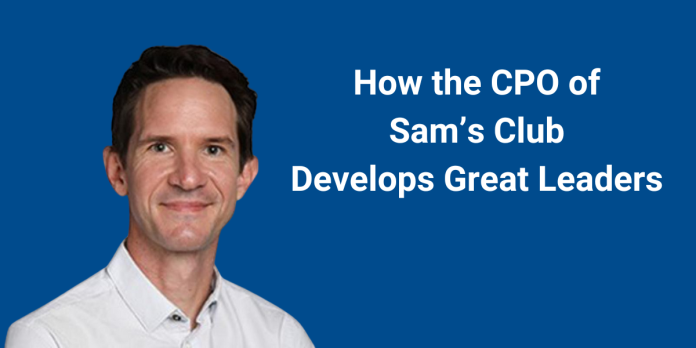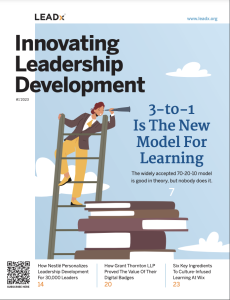
Christopher Shryock began his role as the SVP and Chief People Officer of Sam’s Club nearly two years ago, in the midst of the pandemic. Responsible for all aspects of human resources for Sam’s Club, Shryock had (and still has) his work cut out for him. How, for example, does he scale leadership development and culture to 100,000 associates across 600 locations? And, with so much under his purview, how does he decide which problems and ideas to focus his attention on?

During this interview, Shryock shared how he approaches each of these challenges, and he shared a whole lot more. He spoke about how Sam’s Club is building an ongoing system of measurement to capture a constant pulse on employee engagement. He spoke about how the organization has evolved their frontline leadership programs to happen “on the floor” in the flow of work. He spoke about the issues that keep him up at night. And, he spoke about the lessons he’s learned so far on the job. Throughout the conversation, one thing became very clear: Shryock is immensely thoughtful about his approach and how he focuses his time and energy. Despite how unique his role is, his insights and examples offer immense value to anyone in the HR function.
This interview has been lightly edited for clarity and length.
Building an Ongoing System of Measurement around Employee Engagement and Culture
Kevin Kruse: How do you think about and measure employee engagement at Sam’s Club?
Christopher Shryock: I think about engagement as a way to understand if people connect with and want to be part of our culture.
In terms of measurement, our goal is to have a clear and concise definition of engagement, as well as to better understand what drives engagement. I think about several components when it comes to measurement:
First, I think about the “ultimate measure,” the employee net promoter score which asks associates, how likely are you to recommend the company as a place to work to a good friend or to a family member? Second, we have tried to be more prescriptive in how we define engagement. To me, this is about assessing and understanding some basic constructs. Are our associates energized by their work? Are they supported in their work? And is Sam’s Club an organization that people are proud to work at? Third, we measure each of these constructs, and many other elements about our culture, with a broad annual engagement survey.
At the same time, we're working on enabling an “always on” listening process. We want to have that engagement and cultural data, as well as data from associate listening forums, other surveys, and external sources. The idea is to build this continual sense of the pulse of the organization. Where are people now? Are they fundamentally connecting with the culture and with the company? Do they want to be part of it?
The Pyramid of Engagement at Sam’s Club
Kruse: Through your measurement, what have you found are the big drivers of culture and engagement at Sam’s Club?
Shryock: It’s a tough question to answer because there are so many things that can have an impact on engagement. For Sam’s, I think of our drivers as being kind of like Maslow’s Hierarchy of Needs, in the sense that each layer is essential to having the next layer. Psychological safety is that bottom layer. If you don’t have psychological safety, it’s going to be tough for you to be engaged. The next layer is inclusivity. Do you have a culture that is truly and genuinely inclusive? Is the culture caring? Is your perspective listened to and heard? The third piece as we move up the pyramid is the type of manager that you have and work for. Managers set the tone of your culture. This is especially true on the front line. At Sam’s Club, we have 600 clubs across the U.S. and Puerto Rico, each with Club Managers and Team Leads. Those frontline leaders set the tone and they empower their associates to do their jobs and make decisions. The fourth piece is the team, the individuals you're working with. Are you encouraged to try new ideas? Is success celebrated? Lastly, the fifth level is career growth. Are you able to grow and have a career? Are you able to develop? Do you feel like you have the resources you need?
Developing Frontline Managers: A Common Foundation, but Tailored by Role
Kruse: I’m looking at this pyramid of engagement at Sam’s Club and its third layer specifically, and one of the audiences we work with most often at LEADx is frontline managers. I’d love to hear about your frontline leaders and how you’re developing them.
Shryock: My belief is that frontline managers set the tone for everything our associates experience. They enable the culture, define the standards, and drive the results of the business. My role is to ensure that our frontline managers have the skills to be great managers, in addition to being great operators. Six months ago, we launched a new Manager Quality program in Sam’s to help associates understand how to identify, develop, manage, and reward talent. Our program is intended for all associates in the frontline, from an hourly associate at the membership desk to associates decorating cakes, up to a club manager or a supply chain site leader.
There’s a lot of that content that’s common for all associates. For example, I think everybody should understand concepts of continuous improvement, how to solicit ideas from people that you work with, and what a basic development plan looks like. But there are some things that a Club manager or a team lead needs to be competent in that other associates might not. For example, how do you truly become a sponsor, and how do you build effective teams? Those topics aren’t as relevant for an associate who is not a manager, working at the membership desk. But that person at the membership desk probably should know how to lead by example.
Because we have a common curriculum for all associates, as well as content that is bespoke to specific roles, the impact is that as our associates are promoted and move up (75% of our managers started as hourly), the content becomes dynamic. Lastly, the delivery mechanism to the frontline is the part that I'm the proudest of. Nearly everything is delivered entirely on handheld devices in the flow of work via micro- or nano-learnings.
Moving Learning out of Classrooms and into the Flow of Work
Kruse: I’d love to hear more about how you adjusted your delivery to micro-learnings in the flow of work for frontline leaders.
Shryock: I’ve devoted a significant amount of my focus and attention to moving learning out of the classroom and into the flow of work on handheld devices.
Learning on devices accomplishes three things for our frontline: One, associates can access learning while they’re on the floor in front of members. Two, associates can apply those learnings in real time. Third, associates can recall learning as they need it. I believe that our associates’ work should be “open book tests.” We want our associates to have the information they need at the moment they need it.
Kruse: When my now grown teens were doing retail, they would always be told, you're not allowed to bring your cell phone to work. They don't want people distracted on the floor, surfing Snapchat. So, I’m curious, did you get any pushback against learning in the flow of work?
Shryock: No, our associates already use handheld devices to do their jobs. When a member has a question, there's an app our associates use. Apps are what associates use to monitor feedback from our members or to check inventory levels on exercise bikes. Adding learning to these devices felt natural and easy.
Kruse: What made you decide to make the switch to in the flow of work?
Shryock: When I toured clubs, I felt like people development wasn’t happening where daily work was happening. We've got to be right there, where associates are doing every other aspect of their job. Learning can’t be something that's carved off to the side. If your learning program is not integrated with business processes, you're really missing the mark. You're never going to be able to sustain it.
Two Things that Keep Shryock up at Night
Kruse: You have this huge role where you impact so many people. I’m curious what kinds of things keep you up at night?
Shryock: The first thing is this idea of skills. I was looking at the World Economic Forum and their top 10 skills for the future. If you look at that list for 2025, there are some skills that I think we absolutely can develop in others: people management, analytics, and programming. But there are a lot of other critical skills that I don't know how to develop. I don't know how to develop judgment, critical thinking, resilience, or emotional intelligence. At the same time, I agree with the report. The companies that figure out how to develop or hire leaders with those skills will be the ones who win in today's more anxious, fragile, and non-linear world.
The second thing that keeps me up at night is wellness and mental well-being. For the last three years, it's been especially hard for a lot of people to take care of their own mental well-being. COVID, the new ways of working, and other societal events that affect associate well-being……People are really struggling. And these stressors impact people differently. As organizations, we have to double down on procuring and communicating tools and resources that help people with their mental well-being. Organizations need to communicate that they care, and they need to support employees with resources like virtual counseling, online chat forums, and proactive mental healthcare.
Three Pieces of Advice for CPOs
Kruse: You’ve been the CPO at Sam’s Club for almost two years now. I’m curious, if you were to start over from scratch, what advice would you give yourself knowing what you know now?
Shryock: I would have a few things I would remind myself to do…
First, know what's going on in the world. World events are not abstractions. They impact how employees feel. They inform opportunities and innovation for organizations. They inform what makes a company, a leader, and a CPO. You have to understand and play a role in broader society.
Second, know the business and the people. Spend time understanding the strategy and the initiatives, the thinking behind it, and how the ecosystem connects. Spend time in the market, seeing how it comes to life. What works, what doesn't? How does that impact associates? You also have to talk to people. I don't think you can really do a job like mine from behind a desk at corporate. Look at the data, sure, but don’t forget to meet people for lunch or coffee. I think you'll be amazed at what you learn.
Third, don't try to do it all. I've made that mistake more than once in my career. I had the 19-point HR agenda where you're on page forty of a presentation and nobody really knows where you're going or what you’re focused on. To me, if it takes you more than two minutes to articulate what you’re focusing on in terms of a people agenda, you're doing it wrong. Look at the strategy of the business, look at some data, and then pick a few key things. Focus on them. Drive them. Measure them. Then, you can come back next year and make the agenda even better. You can think about what you want to sustain, what you want to improve, and what new initiatives you might want to add (if any). It’s imperative to push back on that instinct to do everything.






